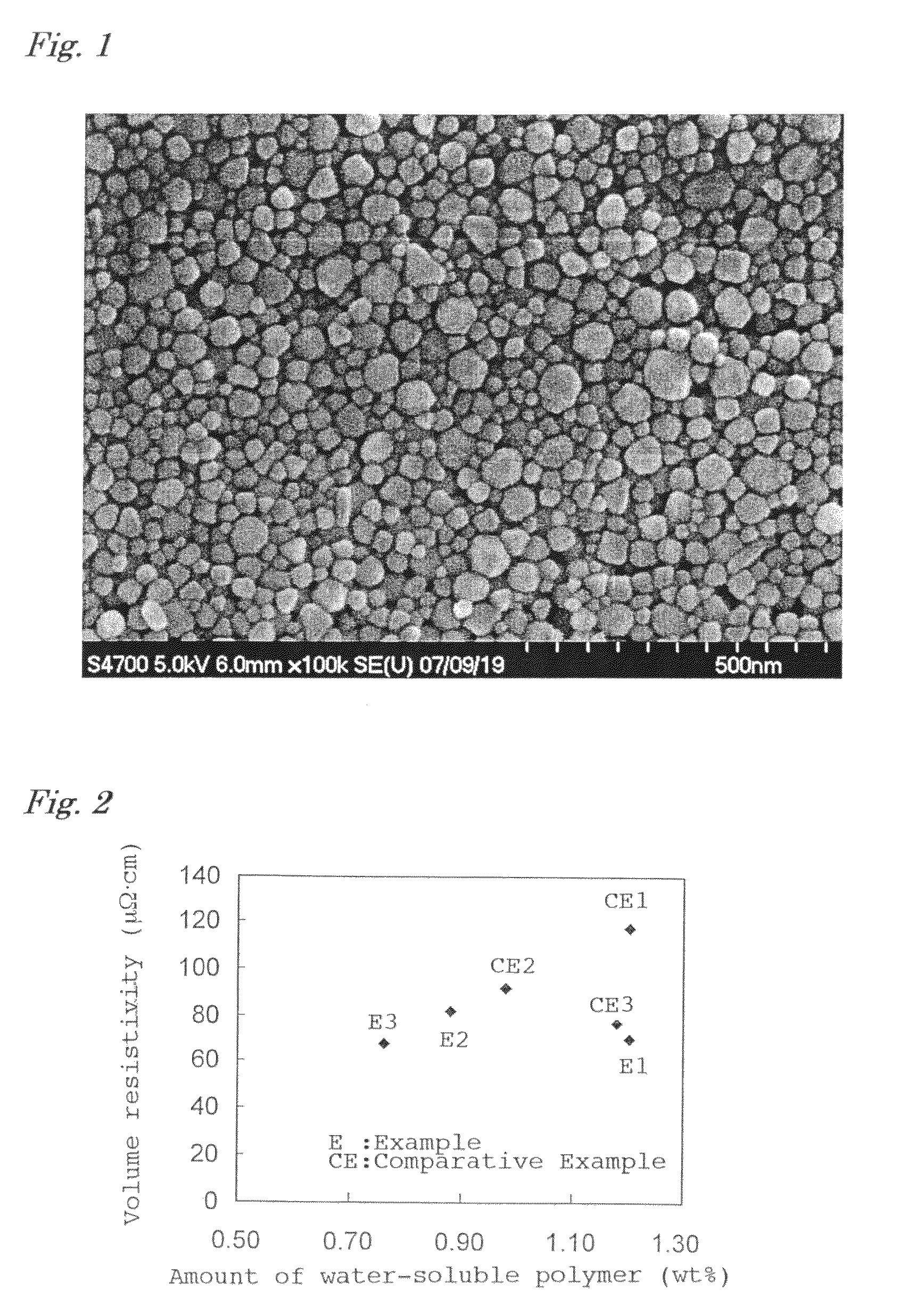Copper fine particles, method for producing the same, and copper fine particle dispersion
a technology of copper fine particles and fine particles, which is applied in the direction of metal/alloy conductors, conductors, transportation and packaging, etc., can solve the problems of halogen being particularly harmful, affecting the performance of the insulation system, and affecting the insulation performance of the system, so as to achieve low undesirable halogen content, high dispersion, and small particle size
- Summary
- Abstract
- Description
- Claims
- Application Information
AI Technical Summary
Benefits of technology
Problems solved by technology
Method used
Image
Examples
example 1
[0069]600 g of copper oxide (Cu2O) powder with a chlorine content of 40 ppm by mass was added to 3 L of a 0.1 mol / l aqueous sodium hydroxide solution to obtain a suspension, and the suspension was stirred at 80° C. for 1 hour and then filtered to collect copper oxide (Cu2O). The copper oxide (Cu2O) was added to 3 L of pure water, stirred for 30 minutes, filtered, and vacuum-dried at 80° C. to obtain washed Cu2O powder. The chlorine content in the washed Cu2O powder was 2 ppm by mass relative to Cu.
[0070]On the other hand, 10 g of polyethyleneimine (PEI) with a chlorine content of 3000 ppm by mass was diluted with water so that the concentration of PEI was 10% by mass to obtain a solution of PEI, and then 10 g of an anion exchange resin (SA-10A manufactured by Mitsubishi Chemical Corporation) converted to the OH− form using an aqueous sodium hydroxide solution was added thereto, and the PEI solution containing the anion exchange resin was stirred for 8 hours. Then, the anion exchange...
example 2
[0078]Copper fine particles were precipitated by reduction in the same manner as in Example 1 except that the amount of the washed PEI was reduced to 1.13 g. The total chlorine content in the raw materials was 5 ppm by mass relative to copper, and the mass ratio of PEI to copper was 0.0113. The obtained copper fine particles were collected by filtration and observed by SEM, and as a result, agglomeration was not observed. The copper fine particles had an average particle size d of 31 nm and a relative standard deviation (standard deviation σ / average particle size d) of 51%.
[0079]Then, a major part of the solvent, ethylene glycol (EG) of the solution containing the obtained copper fine particles was replaced with water in the same manner as in Example 1 to prepare a copper fine particle dispersion. The thus obtained copper fine particle dispersion was analyzed, and the result of analysis was as follows: Cu: 54% by mass, Pd: 0.05% by mass, Na: less than 10 ppm by mass, Mg: less than 1...
example 3
[0082]Copper fine particles were precipitated by reduction in the same manner as in Example 1 except that the amount of the washed PEI was reduced to 0.75 g. The total chlorine content in the raw materials was 5 ppm by mass relative to copper, and the mass ratio of PEI to copper was 0.0075. The obtained copper fine particles were collected by filtration and observed by SEM, and as a result, agglomeration was not observed. The copper fine particles had an average particle size d of 45 nm and a relative standard deviation (standard deviation σ / average particle size d) of 47%.
[0083]Then, a major part of the solvent, ethylene glycol (EG) of the solution containing the obtained copper fine particles was replaced with water in the same manner as in Example 1 to prepare a copper fine particle dispersion. The thus obtained copper fine particle dispersion was analyzed, and the result of analysis was as follows: Cu: 56% by mass, Pd: 0.05% by mass, Na: less than 10 ppm by mass, Mg: less than 1...
PUM
| Property | Measurement | Unit |
|---|---|---|
| particle size | aaaaa | aaaaa |
| volume resistivity | aaaaa | aaaaa |
| particle size | aaaaa | aaaaa |
Abstract
Description
Claims
Application Information
 Login to View More
Login to View More - R&D
- Intellectual Property
- Life Sciences
- Materials
- Tech Scout
- Unparalleled Data Quality
- Higher Quality Content
- 60% Fewer Hallucinations
Browse by: Latest US Patents, China's latest patents, Technical Efficacy Thesaurus, Application Domain, Technology Topic, Popular Technical Reports.
© 2025 PatSnap. All rights reserved.Legal|Privacy policy|Modern Slavery Act Transparency Statement|Sitemap|About US| Contact US: help@patsnap.com


